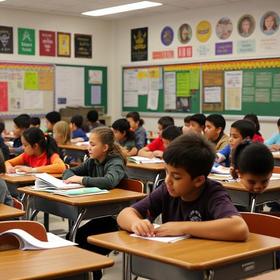How Well Do Single-Sex Schools Really Work?
Public schools that provide single-sex education, whether through classroom segregation or separate schools, may be few and far between today. However, as more evidence surfaces on the different learning styles of boys and girls, the trend appears to be surely – albeit slowly – increasing. Do single-sex schools enhance the academic experience and improve performance for both male and female students? Upon analyzing the research, the answer to that question may be far from simple.
The History of Single-Sex Education
The first schools in America were started by the Puritan settlers and were modeled after the schools in England that were familiar to this population. According to the website of the American Council for CoEducational Schooling, those early schools were primarily designed for the education of the white, Christian male. The school was held for nine months, and then boys were given summers off to help their families with farming responsibilities. During the summer, girls could sometimes attend school, with classes taught by a female teacher.
Coeducation began to appear in North America during the 1700s and became more prevalent after the Revolutionary War, when the importance of educating women to be responsible, well-informed citizens began to be recognized. In 1918, laws had been passed in all states requiring elementary-age students to attend school. At that point, nearly all the schools in the United States were coeducational, with the exception of Catholic schools that primarily remained single-sex institutions.
Since that time, the U.S. public education system has remained primarily coeducational, although private and parochial schools continued to subscribe to the single-sex model in many instances. More recently, public schools have also delved into single-sex classrooms and schools after compelling evidence began to surface that this model might be beneficial to both male and female students.
This video discusses single-sex education.
Studies in Single-Sex Education
According to the National Association for Single-Sex Public Education, studies on the subject fall into three basic categories:
- Nationwide Studies – Conducted in countries like Australia and the U.K., where single-sex education is widely accessible, these studies could involve as many as hundreds of thousands of students overall.
- “Before and After” Studies – This research looks at the performance of specific schools both before single-sex education was introduced and after it was used for a period of time. Studies allow schools to serve as their own control, since student ratios, instructors, and curriculum often remain the same throughout the study.
- Academic Studies – These studies involve academics or researchers analyzing both coeducation and single-sex schools to determine similarities and differences between the two.
The National Association for Single Sex Public Education cites a number of studies in all three of these categories that show students in single-sex classrooms tend to perform better academically than their colleagues in coed schools. In one study conducted in Florida, the results showed the considerable following differences:
- Boys in coed classes scored 37% proficient on standardized tests
- Girls in coed classes scored 59% proficient on standardized tests
- Boys in single-sex classes scored 75% proficient on standardized tests
- Girls in single-sex classes scored 86% proficient on standardized tests
While there are numerous studies that indicate academic performance is higher in single-sex schools, there is equally compelling evidence that indicates just the opposite. For example, according to a study conducted by an economist and professor from Eitan Berglas School of Economics in Tel Aviv, coeducational classrooms with a predominance of female students tended to demonstrate higher academic performance overall.
Benefits of Single-Sex Classrooms
Proponents of same-sex classes tout several benefits from this classroom structure, including:
- Elimination of distractions caused by the opposite sex, particularly in the pubescent learning years
- Ability to use teaching techniques geared explicitly to how boys or girls learn best
- The breakdown of gender stereotypes, which appear to be more prevalent in coeducational classrooms
- A single-sex format offers opportunities to teachers and students that may not exist in the coed classroom
Proponents also point to the success of many single-sex schools across the country as evidence that single-sex education is effective. For example, the reports on an all-male school in Chicago, the Urban Prep Academy. According to the APA, the first year the school opened in 2006, the students that attended had a dismal four-percent reading proficiency level. By the time this inaugural class graduated four years later, 100 percent had been accepted to four-year colleges or universities, and many had been offered academic scholarships.
Drawbacks to Single-Sex Education
While the evidence is compelling, opponents of single-sex education have equally damning evidence against the practice. An article at cites psychologists and educators who disregard evidence that single-sex education works and instead claim it fosters sexism that gets in the way of a positive learning environment.
“The bottom line is that there is not good scientific evidence for the academic advantages of single-sex schooling,” Lynn S. Liben, psychology professor at Penn State told Science 2.0. “But there is strong evidence for negative consequences of segregating by sex – the collateral damage of segregating by sex.”
Even the legal ramifications of single-sex schooling are a matter of debate. On the one hand, federal regulations were eased in 2006, allowing schools to offer single-sex classes and schools, as long as the option is entirely voluntary for students and parents. At the same time, organizations like the American Civil Liberties Union assert that single-sex education is unconstitutional, and it has filed suits against schools that have offered that option.
The issue of same-sex education may be moot for many Americans since the number of single-sex schools is still relatively small. However, as the trend toward single-sex education continues, the debate over whether this is the best way to educate America’s children is also sure to grow.
Questions? Contact us on Facebook and Instagram. @publicschoolreview.
#SingleSexEducation #GenderLearning #EducationResearch #SchoolPerformance #AcademicDebate











